 Earth & Space
Earth & Space
When One Disaster Follows Another
Disasters such as hurricanes, floods, and wildfires are increasing in frequency, and many locations are experiencing repeated disasters. Each disaster can create legacy conditions that affect the outcome of the disasters that follow. New research is helping to understand and predict these important legacies.

In September 2017 Hurricane Irma passed close to Puerto Rico, and its torrential rainfall and high winds led to widespread power outages, saturated ground, blocked roads, and damaged water systems. Just two weeks later, Hurricane Maria moved directly across the island with sustained winds of 69 m/s and gusts up to 76 m/s. It was the third-strongest storm to make landfall in the United States. Partly because of the previous hurricane as well as the ferocity of Hurricane Maria, Puerto Rico was overwhelmed. Emergency supplies, distribution systems, and recovery responses were inadequate, leading to the deaths of more than 4,000 persons.
When one disaster follows another in the same area, the first event creates legacy conditions that can directly affect the outcome of the next disaster. These events, called “recurrent acute disasters”, are occurring with more frequency, intensity, and harm. Treating disasters as individual events is no longer enough. The increase in recurrent disasters requires a change—if not a complete rethinking—of how we prepare for disaster, respond to emergencies, and plan for recovery.
This rethinking is important to governments, corporations, communities, households, and individuals. Over the last decade, tropical storms have increased in strength and shifted closer to coastal communities. Floods are occurring at shorter intervals. Wildfires have become more severe, and fire seasons have expanded. Repeated urban extreme heat events have become a public health hazard. The threat of recurrent acute disasters is caused both by climate change and the trend of people increasingly moving to risky locations, like settlements in forests that have a history of burning or coastal areas exposed to hurricane flooding. These impacts of recurrent acute disasters on environmental quality, economic activity, and public health are, in the language of disaster science, “differentially distributed”—with low-income, underrepresented communities facing the most grievous harms.
Research is revealing how important understanding legacy conditions can be for improving the resilience of communities and protecting public safety. For example, wildfire science has documented how slopes burned by severe fires become highly vulnerable to erosion and landslides when rains arrive. Earthquake studies show that infrastructure not engineered to withstand repeated quakes weakens significantly. Other legacy conditions of disasters—such as pollution in vulnerable communities or the health impacts on first responders—are now being explored. Positive legacies are also important—improved disaster preparedness and hardened infrastructure are examples.
We recently developed a framework for learning how to research and predict the effect of recurrent acute disasters. Some of the results are surprising. Not all legacy conditions are harmful. Hurricane Sandy’s 2010 impact on New York City and the recurrent disasters in Puerto Rico 2017-2020 have led to hardened infrastructure, improved emergency response capacity, and greater public awareness of risk. These locales may now be more resilient and better prepared for future disasters.
What are the practical implications of treating disasters as a recurrent series of events? Quick revision of preparedness plans is essential. As a disaster recedes, its legacy conditions need to be rapidly assessed for their potential impacts on the next disaster. Examples would be the fast mapping of weakened energy grids and timely updates of evacuation routes based on damage to roads.
Public health services need to be able to rapidly re-position medical supplies, with restoration of emergency clinics, pharmacies, health data systems, and public health communication systems being a priority. An example is the need for quick and robust restoration of electrical power for operating critical medical devices--such as dialysis machines or ventilators that are needed by at-risk individuals.
There are other ways that planners and managers can help build resilience to recurrent acute disasters. Land-use policies, building codes, and community preparedness training can all be improved to adapt to recurrent acute disasters and their legacy conditions.
As the science of recurrent acute disasters advances, more accurate predictions and more effective preparations are possible. Understanding and preparing for recurrent acute disasters has the potential to improve disaster response, build resilience to future disasters, and save lives.
Original Article:
Machlis, G., Román, M. & Pickett, S. A framework for research on recurrent acute disasters. Science Advances 8, (2022). - https://doi.org/10.1126/sciadv.abk2458Edited by:
Dr. Rik Voorhaar , Senior Scientific Editor
We thought you might like
More from Earth & Space
Discovery of the first radiation belt beyond the Solar System
Jan 27, 2025 in Earth & Space | 3.5 min read by Juan Bautista Climent OliverOne million (paper) satellites
Jan 24, 2025 in Earth & Space | 3 min read by Ewan Wright , Andrew FalleVolcanic Ash: A Nutrient Boost for Reef-Building Corals
Sep 18, 2024 in Earth & Space | 4 min read by Frank Förster , Tom SheldrakeAmmonia Energy: A Call for Environmental Awareness
Aug 29, 2024 in Earth & Space | 3.5 min read by Matteo Bertagni , Robert Socolow , Amilcare PorporatoLikely increase in coral thermal tolerance at a Pacific archipelago
Dec 29, 2023 in Earth & Space | 3 min read by Liam LachsEditor's picks
Trending now
Popular topics


